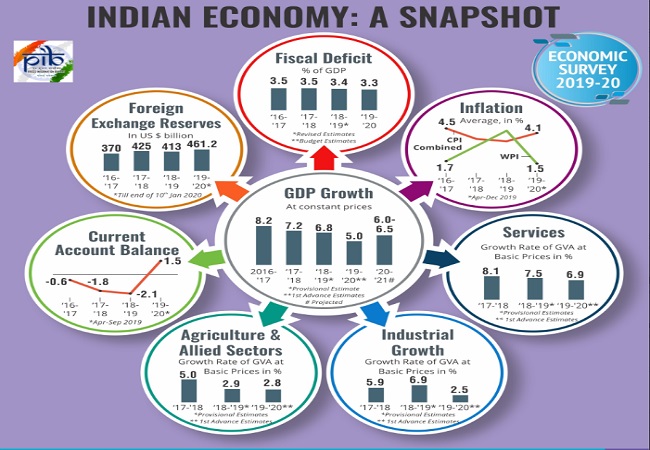
New Delhi: Union Minister for Finance and Corporate Affairs Nirmala Sitharaman presented the Economic Survey 2019-20 in Parliament on Friday. The key highlights of the Economic Survey 2019-20 are as follows:

WEALTH CREATION
* Invisible hand of the market reflected in openness in economic transactions.
* Post-liberalisation, Indian economy supports both pillars of the economic model advocated in our traditional thinking.
* Exponential rise in India’s GDP and GDP per capita post-liberalisation coincides with wealth generation.
* Need for the hand of trust to complement the invisible hand, illustrated by financial sector performance during 2011-13.
* Survey posits that India’s aspiration to become a $5 trillion economy depends critically on strengthening the invisible hand of the market, providing equal opportunities for new entrants, and introducing the idea of trust as a public good, which gets enhanced with greater use.
ENTREPRENEURSHIP
* Entrepreneurship as a strategy to fuel productivity growth and wealth creation.
* India ranks third in a number of new firms created, as per the World Bank.
* 12.2 per cent cumulative annual growth rate of new firms in the formal sector during 2014-18 as compared to 3.8 per cent during 2006-2014.
* About 1.24 lakh new firms created in 2018, an increase of about 80 per cent from about 70,000 in 2014.
* A 10 per cent increase in registration of new firms in a district yields a 1.8 pc increase in Gross Domestic District Product (GDDP).
* New firm formation is the lowest in eastern India with lowest literacy rate (59.6 pc as per 2011 Census).
PRO-BUSINESS VERSUS PRO-MARKETS
* Promoting ‘pro-business’ policy that unleashes the power of competitive markets to generate wealth.
* Weaning away from ‘pro-crony’ policy that may favour specific private interests, especially powerful incumbents.
* An equity index of connected firms significantly outperformed the market by 7 per cent a year from 2007 to 2010, reflecting abnormal profits extracted at common citizens’ expense.
DEBT WAIVERS
* The Survey suggests the government must systematically examine areas of needless intervention and undermining of markets; but it does not argue that there should be no Government intervention.
* Instead it suggests that the interventions that were apt in a different economic setting may have lost their relevance in a transformed economy.
* Eliminating such instances will enable competitive markets spurring investments and economic growth.
JOBS AND GROWTH
* Survey says India has unprecedented opportunity to chart a China-like, labour-intensive, export trajectory.
* By integrating ‘Assemble in India for the world’ into Make in India, India can raise its export market share to about 3.5 pc by 2025 and 6 pc by 2030.
* Exports of network products can provide one-quarter of the increase in value-added required for making India a $5 trillion economy by 2025.
EASE OF DOING BUSINESS
* A jump of 79 positions to 63 in 2019 from 142 in 2014 in World Bank’s Doing Business rankings.
* For merchandise exports, the logistics process flow for imports is more efficient than that for exports, suggests Survey.
* Need for close coordination between the Logistics division of the Ministry of Commerce and Industry, the Central Board of Indirect Taxes and Customs, Ministry of Shipping and the different port authorities.
* Individual sectors such as tourism or manufacturing require a more targeted approach that maps out the regulatory and process bottlenecks for each segment.
BANKING SECTOR
* A large economy needs an efficient banking sector to support its growth.
* The onus of supporting the economy falls on the PSBs accounting for 70 per cent of the market share in Indian banking.
* PSBs are inefficient compared to their peer groups on every performance parameter.
* In 2019, investment for every rupee in PSBs, on average, led to the loss of 23 paise, while in NPBs it led to the gain of 9.6 paise.
* The Survey suggests the representation on boards proportionate to the blocks held by employees to incentivise employees and align their interests with that of all shareholders of banks.
* Creation of a GSTN type entity that will aggregate data from all PSBs and use technologies like big data, artificial intelligence and machine learning in credit decisions for ensuring better screening and monitoring of borrowers, especially the large ones.
PRIVATISATION AND WEALTH CREATION
* The strategic disinvestment of government’s shareholding of 53.29 per cent in HPCL led to an increase of around Rs 33,000 crore in national wealth.
* Financial indicators such as net worth, net profit, return on assets (ROA), return on equity (ROE) etc of the privatized CPSEs, on an average, have improved significantly.
* Privatized CPSEs have been able to generate more wealth from the same resources.
* The Survey suggests aggressive disinvestment of CPSEs to bring in higher profitability, to promote efficiency, increase competitiveness, and promote professionalism.
INDIA’S GDP GROWTH
* GDP growth is a critical variable for decision-making by investors and policymakers. Therefore, the recent debate about the accuracy of India’s GDP estimation following the revised estimation methodology in 2011 is extremely significant.
* Models that incorrectly over-estimate GDP growth by 2.7 per cent for India post-2011 also misestimate GDP growth over the same period for 51 out of 95 countries in the sample.
THALINOMICS
* An attempt to quantify what a common person pays for a ‘Thali’ across India.
* A shift in the dynamics of ‘Thali’ prices since 2015-16.
* Average household gained close to Rs 11, 000 on average per year from the moderation in prices in the case of vegetarian ‘Thali’
* Average household that consumes two non-vegetarian ‘Thalis’ gained close to Rs 12, 000 on average per year during the same period.
* Affordability of vegetarian ‘Thalis’ improved 29 pc.
* Affordability of non-vegetarian ‘Thalis’ improved by 18 per cent.
Economic Performance in 2019-20
* India’s GDP growth moderated to 4.8 per cent in H1 of 2019-20, amidst a weak environment for global manufacturing, trade and demand.
* Real consumption growth has recovered in Q2 of 2019-20, cushioned by significant growth in government final consumption.
* Current Account Deficit (CAD) narrowed to 1.5 pc of GDP in H1 of 2019-20 from 2.1 pc in 2018-19.
* Headline inflation expected to decline by year-end.
FISCAL DEVELOPMENTS
* Revenue Receipts registered a higher growth during the first eight months of 2019-20, compared to the same period last year, led by considerable growth in Non-Tax revenue.
* Gross GST monthly collections have crossed the mark of Rs 1 lakh crore for a total of five times during 2019-20 (up to December 2019).
BALANCE OF PAYMENTS
* India’s BoP position improved from US$ 412.9 billion of forex reserves in end-March, 2019 to US$ 433.7 billion in end September 2019.
* Current account deficit (CAD) narrowed from 2.1 per cent in 2018-19 to 1.5 pc of GDP in H1 of 2019-20.
* Foreign reserves stood at US$ 461.2 billion on January 10, 2020.
GLOBAL TRADE
* In sync with an estimated 2.9 per cent growth in global output in 2019.
* Global trade is estimated to grow at 1 pc after having peaked in 2017 at 5.7 per cent.
* It is projected to recover to 2.9 per cent in 2020 with recovery in global economic activity.
EXPORTS
* The merchandise exports to GDP ratio declined, entailing a negative impact on BoP position.
* Slowdown of world output had an impact on reducing the export to GDP ratio, particularly from 2018-19 to H1 of 2019-20.
* Growth in Non-POL exports dropped significantly from 2009-14 to 2014-19.
* Large Crude oil imports in the import basket correlates India’s total imports with crude prices.
* As crude price raises so does the share of crude in total imports, increasing imports to GDP ratio.
LOGISTICS INDUSTRY OF INDIA
* Currently estimated to be around US$ 160 billion.
* Expected to touch US$ 215 billion by 2020.
* According to World Bank’s Logistics Performance Index, India ranks 44th in 2018 globally, up from 54th rank in 2014.
* Net FDI inflows continued to be buoyant in 2019-20 attracting US$ 24.4 billion in the first eight months, higher than the corresponding period of 2018-19.
* Net FPI in the first eight months of 2019-20 stood at US$ 12.6 billion.
EXTERNAL DEBT
* Remains low at 20.1 per cent of GDP as at end September 2019.
* After significant decline since 2014-15, India’s external liabilities (debt and equity) to GDP increased at the end of June 2019 primarily by an increase in FDI, portfolio flows and external commercial borrowings (ECBs).
MONETARY POLICY
* Remained accommodative in 2019-20.
* Repo rate was cut by 110 basis points in four consecutive MPC meetings in the financial year due to slower growth and lower inflation.
* However, it was kept unchanged in the fifth meeting held in December 2019.
* In 2019-20, liquidity conditions were tight for initial two months; but subsequently it remained comfortable.
GROSS NON PERFORMING ADVANCES RATIO
* Remained unchanged for Scheduled Commercial banks at 9.3 per cent between March and September 2019.
* Increased slightly for the Non-Banking Financial Corporation (NBFCs) from 6.1 per cent in March 2019 to 6.3 per cent in September 2019.
CREDIT GROWTH
* The financial flows to the economy remained constrained as credit growth declined for both banks and NBFCs.
* Bank Credit growth (YoY) moderated from 12.9 per cent in April 2019 to 7.1 per cent as on December 20, 2019.
* Capital to risk-weighted asset ratio of SCBs increased from 14.3 per cent to 15.1 per cent between March 2019 and September 2019.
PRICES AND INFLATION
* Inflation witnessing moderation since 2014
* Consumer Price Index (CPI) inflation increased from 3.7 per cent in 2018-19 (April to December 2018) to 4.1 per cent in 2019-20 (April to December 2019).
* WPI inflation fell from 4.7 per cent in 2018-19 (April to December 2018) to 1.5 per cent during 2019-20 (April to December 2019).
* During 2019-20 (April-December), food and beverages was the main contributor.
* Volatility of prices for most of the essential food commodities with the exception of some of the pulses has actually come down in the period 2014-19 as compared to the period 2009-14.
* Convergence of headline inflation towards core inflation as per the CPI-C data from 2012 onwards.
FOREST AND TREE COVER
* Increasing and has reached 80.73 million hectare.
* 24.56 per cent of the geographical area of the country.
* Burning of agricultural residues, leading to rising in pollutant levels and deterioration of air quality is still a major concern though the total number of burning events recorded reduced due to various efforts taken.
AGRICULTURE AND FOOD MANAGEMENT
* Largest proportion of the Indian population depends directly or indirectly on agriculture for employment opportunities as compared to any other sector.
* The share of agriculture and allied sectors in the total Gross Value Added (GVA) of the country has been continuously declining on account of relatively higher growth performance of non-agricultural sectors, a natural outcome of the development process.
* GVA at basic prices for 2019-20 from ‘Agriculture, Forestry and Fishing’ sector is estimated to grow by 2.8 per cent.
* Agricultural productivity is also constrained by a lower level of mechanization in agriculture which is about 40 pc in India, much lower than China (59.5 pc) and Brazil (75 pc).
* Livestock sector has been growing at a CAGR of 7.9 per cent during the last five years.
INDUSTRY AND INFRASTRUCTURE
* The industrial sector as per Index of Industrial Production (IIP) registered a growth of 0.6 per cent in 2019-20 (April-November) as compared to 5 pc during 2018-19 (April-November).
* Fertilizer sector achieved a growth of 4 pc during 2019-20 (April-November) as compared to (-) 1.3 per cent during 2018-19 (April-November).
* Steel sector achieved a growth of 5.2 per cent during 2019-20 (April-November) as compared to 3.6 per cent during 2018-19 (April-November).
* Total telephone connections in India touched 119.43 crore as on September 30, 2019.
* The installed capacity of power generation has increased to 3, 64,960 MW as on October 31, 2019, from 3, 56,100 MW as on March 31, 2019.
SERVICES SECTOR
* Services sector accounts for about 55 per cent of the total size of the economy and GVA growth.
* Two-thirds of total FDI inflows into India.
* About 38 per cent of total exports.
* Gross Value Added growth of the services sector moderated in 2019-20 as suggested by various high-frequency indicators and sectoral data such as air passenger traffic, port and shipping freight traffic, bank credit, etc.
* FDI into services sector has witnessed a recovery in early 2019-20.
EMPLOYMENT AND HUMAN DEVELOPMENT
* The expenditure on social services (health, education and others) by the Centre and States as a proportion of GDP increased from 6.2 per cent in 2014-15 to 7.7 pc in 2019-20 (BE).
* India’s ranking in Human Development Index improved to 129 in 2018 from 130 in 2017.
* With 1.34 pc average annual HDI growth, India is among the fastest-improving countries
* Gross Enrolment Ratio at secondary, higher secondary and higher education level needs to be improved.
* The share of a regular wage and salaried employees has increased by 5 percentage points from 18 pc in 2011-12 to 23 pc in 2017-18.
* A significant jump of around 2.62 crore new jobs with 1.21 crore in rural areas and 1.39 crore in urban areas in this category.
* Total formal employment in the economy increased from 8 per cent in 2011-12 to 9.98 per cent in 2017-18. (ANI)




